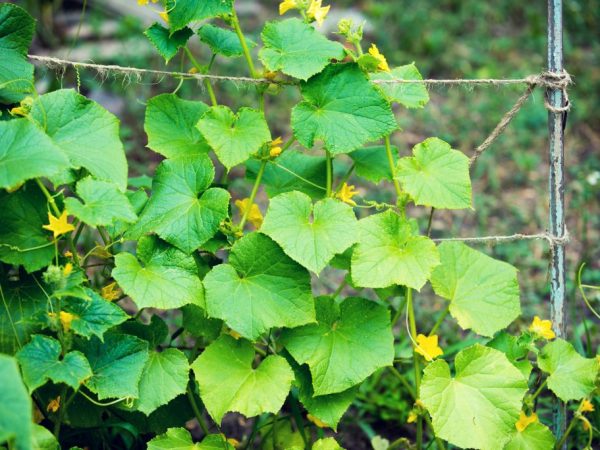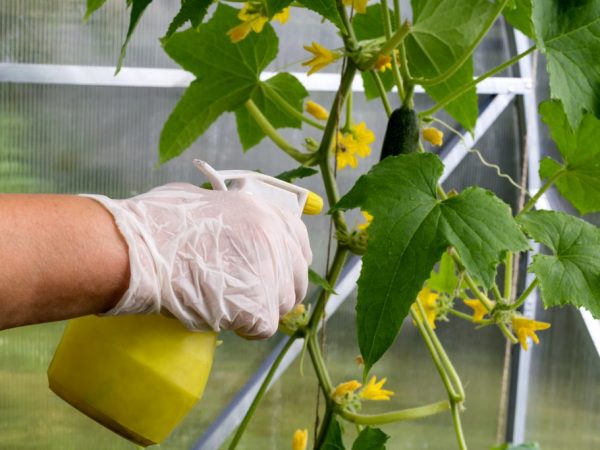The benefits of processing cucumbers with milk
Most gardeners grow cucumbers on their plots. Like any crop, cucumbers require proper self-care. Often the choice falls on folk remedies. One of the most effective methods is processing cucumbers with milk.

The benefits of processing cucumbers with milk
Beneficial features
Milk, due to its valuable composition, is used in the cultivation of various crops. It contains a number of useful substances:
- calcium;
- potassium;
- magnesium;
- manganese;
- iron;
- copper;
- nitrogen;
- phosphorus;
- sulfur, etc.
Milk is an organic product; after its use, vegetables are not saturated with harmful chemicals, and therefore do not pose a threat to human health. The fruits can be eaten immediately.
It is not recommended to use a whole dairy product, because it has a high percentage of fat, due to which it harms plants. When processing crops, in particular cucumbers, it is diluted with water. Solutions are prepared depending on the purpose.
Using
Dairy products are used as fertilizers. Plants and soil absorb nutrients. Milk helps vegetables to assimilate substances that are introduced with other dressings, and is also used as a means of prevention and protection against pests, because lactose is not digested by their organisms. An invisible film forms on the culture, preventing the penetration of pathogens of various diseases.
The dairy product in the compost enhances microbiological activity, protects against the penetration of various insects.
Feeding cucumbers with milk
Cucumbers, like other vegetables in the garden, need fertilization, especially if they grow in poor soil. Top dressing is applied by root and foliar method.
Watering
Thanks to root feeding, nutrients are absorbed faster by bushes. For watering cucumbers with milk, make a solution: add 1 liter of low-fat milk to 5 liters of water, mix thoroughly. One plant requires about 0.5 liters of liquid.
Watering with solutions based on fermented milk products is useful, which can increase yields and prevent premature yellowing and wilting of leaves. To prepare top dressing, 1 liter of sour milk (kefir, whey, yogurt) is diluted in 10 liters of water. One bush accounts for about 1 liter of fertilizer.
Top dressing is carried out throughout the entire growth of cucumbers with an interval of 7-10 days. In this case, the first time fertilization is applied already 3-4 days after planting. Thanks to the potassium contained in the "milk", such feeding is especially useful during the period of fruit formation.
Spraying

Spraying protects the plant from disease
If you sprinkle cucumbers with milk from above, the leaves will absorb the top dressing, a thin film will be created. The plant will receive additional protection from pests and diseases.
For an effective result, other means are added to the dairy product. For example, iodine, which is an antiseptic.Solutions based on milk and iodine have a good effect on cucumbers: they enrich them with useful substances, give a rejuvenating effect (leaves do not turn yellow, new ovaries appear). Plants, when sprayed, receive protection against many diseases. For example, from bacteriosis, gray rot, various types of aphids.
Spraying cucumbers with milk and iodine is carried out using a mixture:
- 1 liter of milk;
- 30 drops of iodine;
- 1 tbsp. l. crushed laundry or liquid soap (it will help the solution to better adhere to the plant).
Everything is thoroughly mixed, after which the bushes are processed. It is permissible to spray the mortar and the ground around them. Cucumbers are treated for prophylactic purposes, when 5-6 true leaves appear on them. They are sprayed not only from above, but also from the back. Such manipulations are carried out every 2 weeks. If there are a lot of bushes on the site, the amount of fertilizer is increased proportionally by adding each ingredient.
Using whey
Disease protection is provided by formulas prepared with the addition of other dairy products. For example, whey. In addition to phosphorus, potassium and magnesium, it contains useful amino acids, therefore it is a high-quality fertilizer and is good against various fungi.
It is recommended to spray the plant against late blight with the following mixture:
- 10 liters of water;
- 1 liter of milk whey;
- 40 drops of iodine;
- 1 tbsp. l. hydrogen peroxide.
Vegetables are sprayed several times a season, the more often the better: fungi do not like this. To achieve the desired result, all parts of the bushes are treated. If the disease has already hit the crop, spraying with a solution will not help.
It is difficult to resist real or downy mildew, therefore, when such a problem arises, gardeners use chemicals.
Application features
Milk is used not thermally processed, because during pasteurization or sterilization, most of the vitamins are destroyed. As a result, the product loses its effectiveness.
Do not pour the solution under the root. A funnel is made around the bush at a distance of 10-15 cm, after which liquid is poured into it. Cucumber roots are located close to the top of the soil and can absorb useful moisture from there. Watering is carried out only after a day.
Leaves are sprayed either in cloudy weather, or after sunset, so that the plant does not burn.
Conclusion
Fertilizer with dairy products is in great demand among gardeners, because it is readily available and multifunctional: it is used both as a top dressing and as a means of protecting against pests. Chemicals do not have such properties. If you water cucumbers with milk correctly, it is easy to get a high-quality and healthy harvest.


